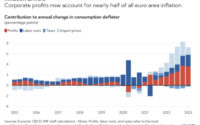India’s Oil Deals With Russia Further Erodes Petrodollar Dominance

Every government policy has consequences – some intended and some unintended.
There is at least one serious unintended consequence of the economic sanctions levied against Russia after its invasion of Ukraine – an erosion of the US dollar dominance.
Reuters reports that recent oil deals between India and Russia have been settled in currencies other than dollars.
The majority of global oil sales are priced in dollars. This ensures a constant demand for the greenback since every country needs dollars to buy oil. This helps support the US government’s “borrow and spend” policies, along with its massive deficits. As long as the world needs dollars for oil, it guarantees demand for greenbacks. That means the Federal Reserve can keep printing dollars to monetize the debt.
But if that demand were to suddenly disappear or even shrink significantly, it would create a big problem for the US economy.
India ranks as the number three oil importer in the world. Russia became the country’s leading provider of crude after Europe dramatically cut Russian oil imports in the wake of the Ukraine invasion. India is also now Russia’s top oil customer.
While India doesn’t recognize the sanctions on Russia, most of its oil purchases have reportedly complied.
Nevertheless, according to the Reuters report, Indian importers have paid for most Russian oil in non-dollar currencies since the Group of Seven economies, the European Union and Australia, imposed an oil price cap on Russia on Dec. 5. Instead of settling oil trades in dollars, Russia and India have used UAE dirham and Russian rubles. These transactions total “several hundred million dollars” according to sources quoted by Reuters.
The dollar’s pre-eminence has periodically been called into question and yet it has continued because of the overwhelming advantages of using the most widely-accepted currency for business. India’s oil trade, in response to the turmoil of sanctions and the Ukraine war, provides the strongest evidence so far of a shift into other currencies that could prove lasting.”
Meanwhile, according to three sources cited by Reuters, “Some Dubai-based traders, and Russian energy companies Gazprom and Rosneft are seeking non-dollar payments for certain niche grades of Russian oil that have in recent weeks been sold above the $60 a barrel price cap.”
And Russia isn’t the only country drifting away from the petrodollar.
In January, Saudi Arabia Finance Minister Mohammed Al-Jadaan said the country is open to discussing trade in currencies other than the US dollar.
“There are no issues with discussing how we settle our trade arrangements, whether it is in the US dollar, whether it is the euro, whether it is the Saudi riyal,” Al-Jadaan said in an interview with Bloomberg TV.
Al-Jadaan went on to say, “I don’t think we are waving away or ruling out any discussion that will help improve the trade around the world.”
The Reuters report notes that beyond Russian sanctions, tensions between the US and China are also “eroding the long-established norms of dollar-dominated global trade.”
Russia holds a chunk of its currency reserves in renminbi while China has reduced its holdings of dollars, and Russian President Vladimir Putin said in September Moscow had agreed to sell gas supplies to China for yuan and roubles instead of dollars.”
Over the last several years, many countries have made a concerted effort to limit dependence on the US dollar. The economic warfare waged against Russia reveals exactly why.
The US hit Russia with a round of economic sanctions after Russian President Vladimir Putin recognized two breakaway republics in Ukraine and announced he would send troops into those regions. President Biden announced additional sanctions after Russia invaded Ukraine.
Using the dollar as a foreign policy tool might be good policy, but could accelerate de-dollarization globally and even threaten the dollar’s role as the world’s reserve currency.
The US government showers billions of dollars in foreign aid to “friends.” On the other hand, “enemies” can find themselves locked out of SWIFT, the global financial system that the US effectively controls using the dollar.
This is the nuclear option when it comes to economic warfare.
Initially, the US said it wouldn’t block Russia from SWIFT, but as sanctions tightened, Russia was ultimately locked out of the global payment system.
It’s no wonder that other countries are wary of relying exclusively on the dollar. The best way to avoid American foreign policy coercion is to minimize dollar exposure.
This is one of the reasons many central banks are stockpiling gold.
While the current de-dollarization trend doesn’t directly threaten the dollar’s role as the world reserve currency — yet — it could foreshadow bigger problems down the road, especially if the trend continues to accelerate. After the Russian invasion, IMF Managing Director Gita Gopinath warned that sanctions on Russia could erode the dollar’s dominance by encouraging smaller trading blocs using other currencies. That’s exactly what we’re seeing.
If the demand for dollars were to plunge significantly, interest rates on US Treasury bonds would soar. This would be an untenable situation for a government servicing more than $31 trillion in debt.
While the world isn’t on the verge of jettisoning the dollar, there does seem to be an increasing likelihood the petrodollar could face competition from other currencies. This is yet another sign that the dollar may eventually lose its status as the sole reserve currency. Americans should be wary of counting on long-term dollar dominance to prop up its house of cards economy.

Call 1-888-GOLD-160 and speak with a Precious Metals Specialist today!
[ad_2]
Source link


